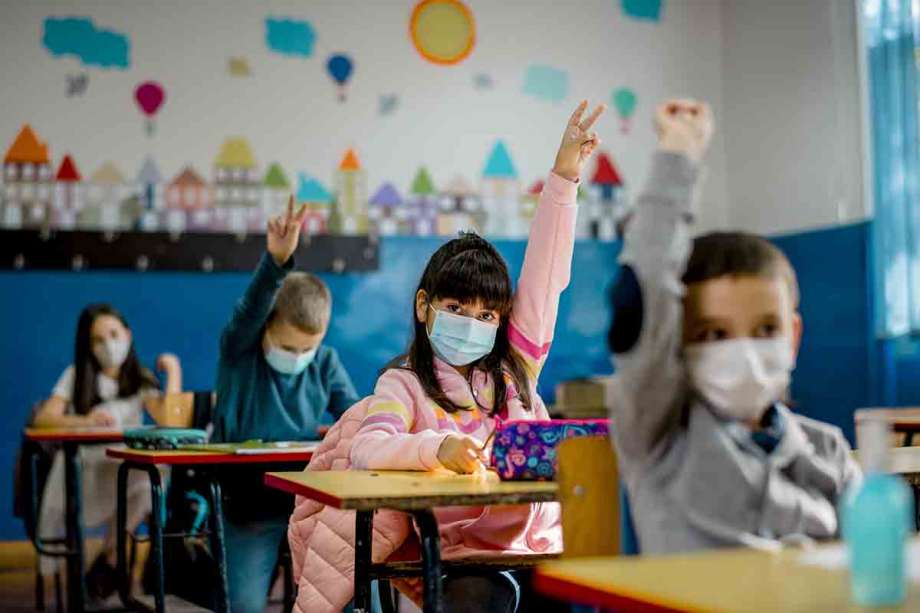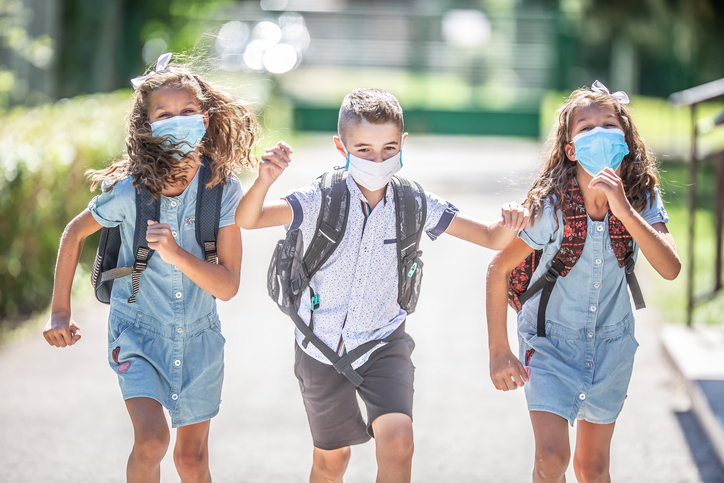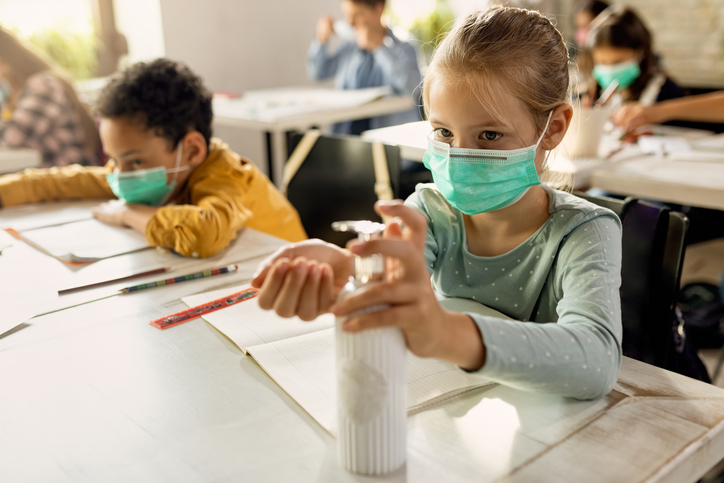Covid Safety Tips For Parents As Kids Head Back to School

Many families and students faced challenges over the last year during the height of the Covid-19 pandemic. With back-to-school around the corner, many districts are making a push for as much in-person learning as possible. Stress and anxiety are likely high for many kids and families who are working to find ways to keep their children safe during the school year while still being able to reunite with their teachers and peers.
More: How to Help Your Child Cope with Back to School Anxiety
Acknowledging your own fears, as well as the stress your child may be carrying is important for maintaining good mental health. Knowledge is power, and we want you to be able to equip yourself and your kids with how best to handle back-to-school in unusual times. We’ve gathered our top safety tips for parents to keep in mind while helping kids head back to school this year.
Face Masks
The American Academy of Pediatrics (AAP) recommends that children ages 2 and older wear masks at school unless a medical or developmental condition prevents it. Masking helps prevent transmission to students who are too young or ineligible for the Covid-19 vaccination. As we see new strands such as the Delta variant emerge, young children and adolescents are becoming more at risk of becoming infected and transmitting coronavirus.
A school day can be a long time to wear a mask, so it’s important to find masks that are lightweight, comfortable, and fit your child well. Cotton masks are breathable and easy to wash making them ideal for daily use. Masks should fit well without any gaps around the nose or mouth, but should not be tight enough to cause discomfort or leave marks on your kid’s face.

If you have a fashionista, these days you can find masks with all kinds of designs, patterns, and colors. Let your kids help pick out their back-to-school masks so they are more excited to wear them. An added benefit of consistent mask use is that there will be lower cases of typical respiratory illnesses such as cold and flu during the winter months.
Safety Tip: Send your child to school daily with a clean mask attached to a mask strap that they can wear around their neck. This prevents it from falling on the floor or getting lost when removed. Keep an extra mask or two in their backpack as a backup when they inevitably need a fresh one.
Hand Washing and Hand Sanitizer
Handwashing and sanitizing are important safety precautions to remind your child about. When we touch contaminated surfaces, it’s easy to forget that hidden invisible germs live on our hands. Without thinking, we touch our face, eyes, and mouth throughout the day, which is an easy way to spread illness. Remind your child to sanitize their hands throughout the day, especially after sharing materials, opening doorknobs, and before eating food.
A great idea is to keep a travel hand sanitizer clipped onto their backpack and lunchbox so that they can properly sanitize their hands if a sink is not accessible. However, remind them that warm water and soap are ideal when available and that sanitizer makes an appropriate backup only when needed.
Schools and teachers are likely to appreciate donations of classroom hand sanitizer and antibacterial soap to keep their classrooms stocked. You may also want to grab some hand lotions to keep your little one’s hands from drying out too badly after all the handwashing and sanitizing.
Safety Tip: Hands should be washed for at least 20 seconds, which can seem like a long time to younger children. Encourage them to sing a round of Baby Shark while washing, or twice through Happy Birthday. 20 seconds will be up before they know it!
Social Distancing
The Centers for Disease Control and Prevention (CDC) currently recommends that students maintain a physical distance of 3 feet within classrooms and school settings to prevent the transmission of COVID-19. Your child’s school and district will likely have policies put into place that you can review. It is important to have conversations with your kids about physical distancing in settings that can get crowded, such as school buses, hallways, and playgrounds.
Throughout the school day, there will be times that are less monitored and you need to empower your child to help stop the spread of COVID-19 by maintaining an appropriate physical distance. If a setting does not allow for 3 feet of physical distance, it is especially important to utilize masks to maintain safety.
Safety Tip: Talk to your kids about what to do when faced with a situation such as on a school bus or at the playground when they don’t feel safe. Find a teacher or adult that they are comfortable going to and speaking up with, “I don’t feel comfortable and I need to find a safe place to sit/play.” This lesson goes beyond so much more than COVID-19 precautions and is a great lesson to practice.
COVID-19 Vaccine
According to the Centers for Disease Control (CDC), vaccination is the leading public health prevention strategy to end the COVID-19 pandemic. Currently, kids ages 12+ are eligible to receive the Pfizer-BioNTech vaccine, which is FDA approved. Choosing to give your child a vaccine can be a sensitive subject and a very personal choice. Ask your pediatrician for literature so that you are receiving accurate information as you weigh your decision.
It may be possible that down the line schools will require staff and students to be vaccinated against coronavirus to continue in-person learning without disruption. Healthcare professionals agree that it will likely become a part of our regularly required immunizations. If your child is eligible to receive the COVID-19 vaccination talk to your pediatrician for information and guidance.
If your child has already received the COVID-19 vaccination, it is still important to review the above safety measures to keep themselves and their peers safe while in a school setting. Empower your child to not only keep themselves safe but to help protect unvaccinated people that they will come into contact with throughout the school day.
When to Keep Your Child Home

The biggest question that is likely to come up this year is when to keep your child home from school. School districts will likely have stipulations in place for when your kid is considered a close contact or has been exposed directly, but what if they just have a sniffly nose?
The main symptoms to monitor for are fever, congestion, cough, sore throat, shortness of breath, fatigue, headache, nausea, vomiting, loss of taste or smell, poor appetite, and muscle aches. Many of these symptoms can easily be other illnesses and not COVID-19, but your child should not attend school if they are sick. In most places, COVID-19 tests are accessible and will be recommended by schools or pediatricians.
If your child does not have COVID-19, once they are able to comfortably participate in daily activities, you should feel comfortable allowing them to return to school as they would any other year. Hopefully, with the use of masks, you will see fewer rounds of the common cold and flu during the winter months. As always, your pediatrician and the school nurse are great contacts to regularly communicate with.

